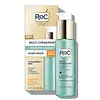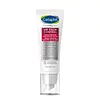RoC Multi Correxion Hyaluronic Acid Daily Moisturizer SPF 30 Versus Cetaphil Pro AR Calm Control SPF 30+
What's inside
What's inside
 Key Ingredients
Key Ingredients

 Benefits
Benefits

 Concerns
Concerns

 Ingredients Side-by-side
Ingredients Side-by-side

Octocrylene 4%
UV AbsorberEthylhexyl Salicylate 4.5%
UV AbsorberHomosalate 5.5%
Skin ConditioningButyl Methoxydibenzoylmethane 2%
UV AbsorberWater
Skin ConditioningPentylene Glycol
Skin ConditioningDimethicone
EmollientOctyldodecanol
EmollientCaprylyl Methicone
Skin ConditioningPropanediol
SolventHyaluronic Acid
HumectantPotassium Cetyl Phosphate
EmulsifyingAmmonium Acryloyldimethyltaurate/Vp Copolymer
Biosaccharide Gum-4
Skin ConditioningJasminum Sambac Leaf Cell Extract
MaskingGlycerin
HumectantDibutyl Lauroyl Glutamide
Skin ConditioningCarbomer
Emulsion StabilisingAminomethyl Propanol
BufferingDibutyl Ethylhexanoyl Glutamide
Skin ConditioningCapryloyl Glycerin/Sebacic Acid Copolymer
Skin ConditioningCaprylhydroxamic Acid
1,2-Hexanediol
Skin ConditioningDisodium EDTA
Parfum
MaskingOctocrylene 4%, Ethylhexyl Salicylate 4.5%, Homosalate 5.5%, Butyl Methoxydibenzoylmethane 2%, Water, Pentylene Glycol, Dimethicone, Octyldodecanol, Caprylyl Methicone, Propanediol, Hyaluronic Acid, Potassium Cetyl Phosphate, Ammonium Acryloyldimethyltaurate/Vp Copolymer, Biosaccharide Gum-4, Jasminum Sambac Leaf Cell Extract, Glycerin, Dibutyl Lauroyl Glutamide, Carbomer, Aminomethyl Propanol, Dibutyl Ethylhexanoyl Glutamide, Capryloyl Glycerin/Sebacic Acid Copolymer, Caprylhydroxamic Acid, 1,2-Hexanediol, Disodium EDTA, Parfum
Water
Skin ConditioningDimethicone
EmollientTitanium Dioxide
Cosmetic ColorantCaprylyl Methicone
Skin ConditioningZinc Oxide
Cosmetic ColorantCetyl Diglyceryl Tris(Trimethylsiloxy)Silylethyl Dimethicone
Emulsion StabilisingGlycerin
HumectantC12-15 Alkyl Benzoate
AntimicrobialIsohexadecane
EmollientDicaprylyl Carbonate
EmollientSilica
AbrasiveAllantoin
Skin ConditioningBenzyl Alcohol
PerfumingCaffeine
Skin ConditioningCI 77288
Cosmetic ColorantCI 77491
Cosmetic ColorantCI 77492
Cosmetic ColorantCI 77499
Cosmetic ColorantDipotassium Glycyrrhizate
HumectantEthylhexylglycerin
Skin ConditioningHydrogenated Lecithin
EmulsifyingMagnesium Sulfate
Methylpropanediol
SolventTocopherol
AntioxidantTriethoxycaprylylsilane
Trisiloxane
Skin ConditioningWater, Dimethicone, Titanium Dioxide, Caprylyl Methicone, Zinc Oxide, Cetyl Diglyceryl Tris(Trimethylsiloxy)Silylethyl Dimethicone, Glycerin, C12-15 Alkyl Benzoate, Isohexadecane, Dicaprylyl Carbonate, Silica, Allantoin, Benzyl Alcohol, Caffeine, CI 77288, CI 77491, CI 77492, CI 77499, Dipotassium Glycyrrhizate, Ethylhexylglycerin, Hydrogenated Lecithin, Magnesium Sulfate, Methylpropanediol, Tocopherol, Triethoxycaprylylsilane, Trisiloxane
 Reviews
Reviews

Ingredients Explained
These ingredients are found in both products.
Ingredients higher up in an ingredient list are typically present in a larger amount.
Caprylyl Methicone is a type of silicone.
It helps soften and soothe the skin by creating a thin film on top. This film helps trap moisture, keeping your skin hydrated.
Dimethicone is a type of synthetic silicone created from natural materials such as quartz.
What it does:
Dimethicone comes in different viscosities:
Depending on the viscosity, dimethicone has different properties.
Ingredients lists don't always show which type is used, so we recommend reaching out to the brand if you have questions about the viscosity.
This ingredient is unlikely to cause irritation because it does not get absorbed into skin. However, people with silicone allergies should be careful about using this ingredient.
Note: Dimethicone may contribute to pilling. This is because it is not oil or water soluble, so pilling may occur when layered with products. When mixed with heavy oils in a formula, the outcome is also quite greasy.
Learn more about DimethiconeGlycerin is already naturally found in your skin. It helps moisturize and protect your skin.
A study from 2016 found glycerin to be more effective as a humectant than AHAs and hyaluronic acid.
As a humectant, it helps the skin stay hydrated by pulling moisture to your skin. The low molecular weight of glycerin allows it to pull moisture into the deeper layers of your skin.
Hydrated skin improves your skin barrier; Your skin barrier helps protect against irritants and bacteria.
Glycerin has also been found to have antimicrobial and antiviral properties. Due to these properties, glycerin is often used in wound and burn treatments.
In cosmetics, glycerin is usually derived from plants such as soybean or palm. However, it can also be sourced from animals, such as tallow or animal fat.
This ingredient is organic, colorless, odorless, and non-toxic.
Glycerin is the name for this ingredient in American English. British English uses Glycerol/Glycerine.
Learn more about GlycerinWater. It's the most common cosmetic ingredient of all. You'll usually see it at the top of ingredient lists, meaning that it makes up the largest part of the product.
So why is it so popular? Water most often acts as a solvent - this means that it helps dissolve other ingredients into the formulation.
You'll also recognize water as that liquid we all need to stay alive. If you see this, drink a glass of water. Stay hydrated!
Learn more about Water